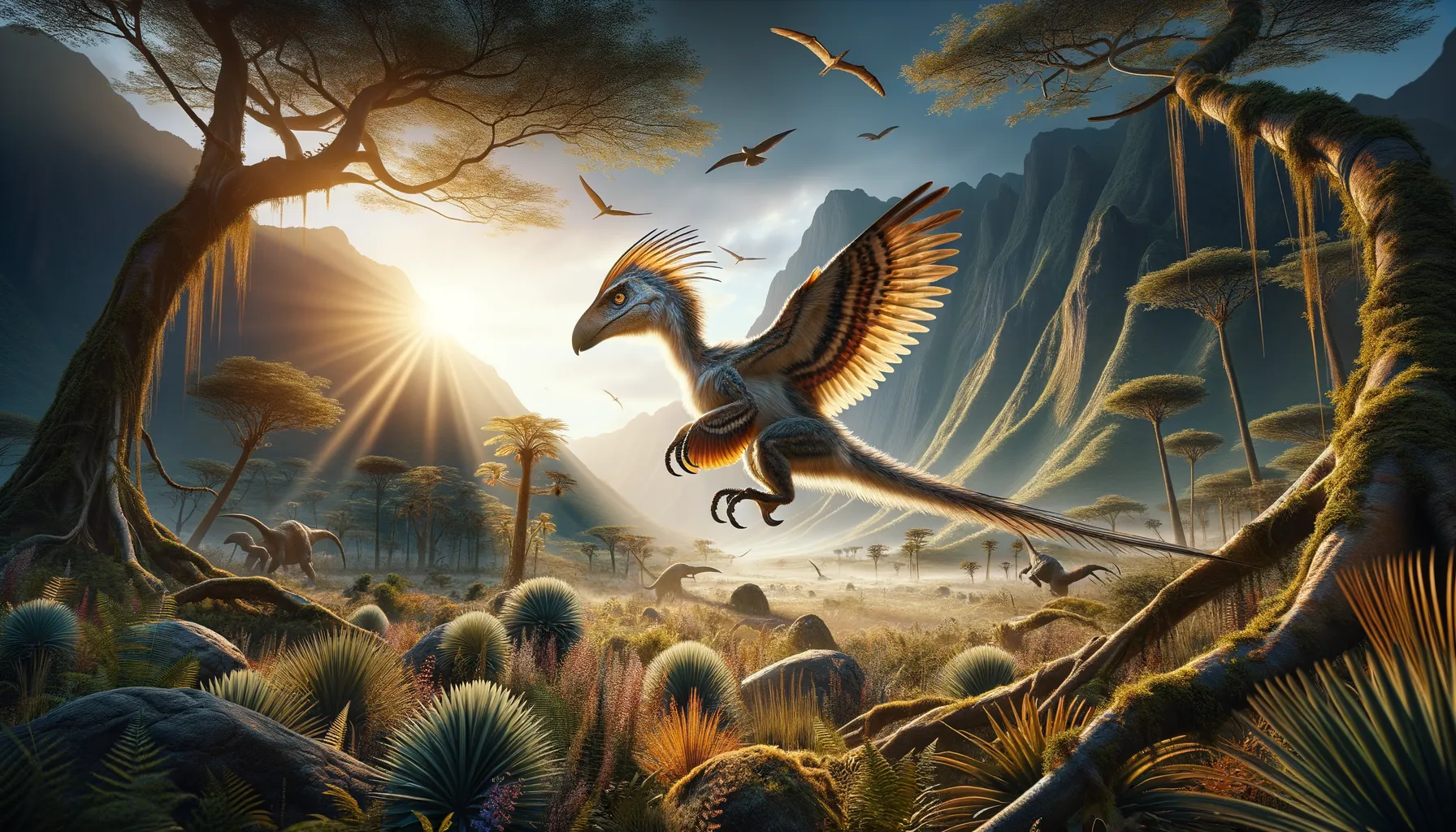
Rahonavis
Small size, big evolutionary steps!
Period
Cretaceous
Length
About 80 centimeters (2.6 feet) long.
Height
Stood approximately 1 foot tall at the hips.
Weight
Estimated to weigh around 1 to 2 kg (2.2 to 4.4 lbs).
Rahonavis, a small bird-like dinosaur, lived during the Late Cretaceous period. Known for its unique blend of bird and dinosaur traits, this species provides crucial insights into the evolutionary transition from dinosaurs to birds. Its fossilized remains revealed features like a tail similar to theropods and wing-like arms, suggesting advanced flying capabilities. This fascinating creature underscores the diversity of predatory behavior and physical adaptations among small Mesozoic vertebrates.
Diet
Rahonavis was likely carnivorous, preying on small vertebrates and insects. Its sharp teeth and claws suggest an active predatory lifestyle.
Hunting
It may have used its agility and flight capabilities to ambush prey. Its hunting style likely involved quick, sudden movements to catch scared animals.
Environmental challenges
During the Late Cretaceous, Rahonavis faced predators larger than itself, requiring it to be vigilant and nimble. The climate changes it experienced forced adaptability in terms of prey availability. This dinosaur lived in a time when flowering plants were increasingly common, reshaping its ecosystem. Despite these challenges, its bird-like traits allowed it to exploit ecological niches.
Speed
Rahonavis was likely swift and agile, aided by its lightweight frame and wing-like arms.
Lifespan
Its lifespan remains uncertain, typical of small theropods.
First discovery
Discovered in 1995 in Madagascar, shedding light on bird-like dinosaurs.
Fun Facts
- Rahonavis was a small dinosaur that lived around 70 million years ago during the late Cretaceous period.
- This dinosaur is known for its bird-like features, such as feathers and a light body, hinting at the evolutionary link between dinosaurs and birds.
- Rahonavis had wings, but like some other small dinosaurs of its time, it might not have been capable of full flight.
- It was discovered in Madagascar, contributing to our knowledge of prehistoric life on the island.
- Rahonavis had a sickle-shaped claw on its second toe, similar to that of the famous raptor dinosaur, Velociraptor.
- Unlike modern birds, its bone structure suggests it was more adapted for running and gliding than sustained flight.
- The name 'Rahonavis' means 'cloud menace bird,' highlighting its mysterious and intriguing nature.
Growth and Development
Rahonavis may have experienced rapid growth into early adulthood, common among small theropods. Feather development could have played a role in thermoregulation and mating displays. Understanding its growth pattern helps clarify the evolutionary trajectory from non-avian dinosaurs to birds. Further fossil evidence is needed to fully comprehend its developmental stages.
Habitat
Rahonavis lived in what is now present-day Madagascar, where it occupied a tropical climate. Its environment had dense vegetation combined with open spaces suitable for both ground hunting and potential flight. This varied landscape offered a diverse range of prey and cover from predators. Its habitat would have been influenced by the presence of rivers and coastlines.
Interaction with other species
Rahonavis likely coexisted with other small theropods and large herbivorous dinosaurs. It may have competed for food with smaller reptiles and other early bird-like creatures. Interactions might include predator-prey dynamics and occasional scavenging. Its agile nature and possible flight capabilities set it apart from many other contemporaries.
Natural lifespan
Rahonavis's natural lifespan is not well-documented.
Reproduction
Rahonavis likely laid eggs, a common reproductive strategy among theropods. It may have exhibited some degree of parental care, as inferred from related species. Nesting sites of its contemporary relatives suggest communal nesting behaviors. While direct evidence is lacking, its reproduction mirrors evolutionary trends toward modern birds.
Social behaviour
Its social behavior is largely speculative, but it might have shown solitary or small group living, similar to some modern bird species. Social interactions could include mating displays or territory defense using vocalizations and visual signals. The presence of feathers supports the idea of complex social behaviors tied to mating rituals. Fossil evidence is insufficient to confirm detailed social patterns.
Fossil locations
Fossils of Rahonavis have been predominantly found in Madagascar. This discovery site highlights the diverse dinosaur fauna of the region during the Late Cretaceous. Additional finds in nearby areas could help map its distribution and variance. Its fossils have provided crucial insights into the evolution of flight in dinosaurs.
